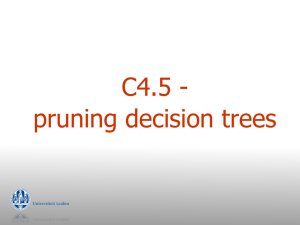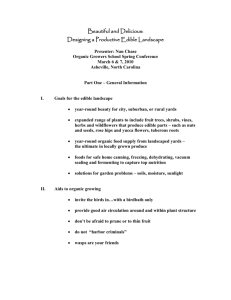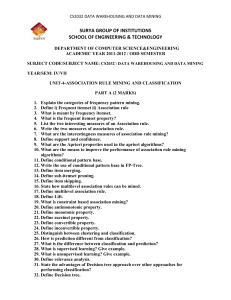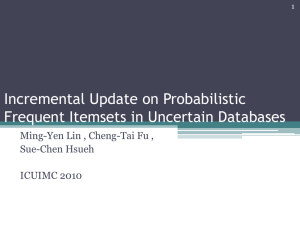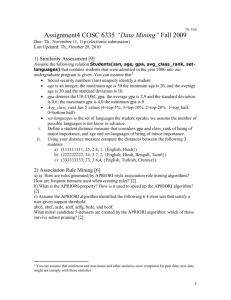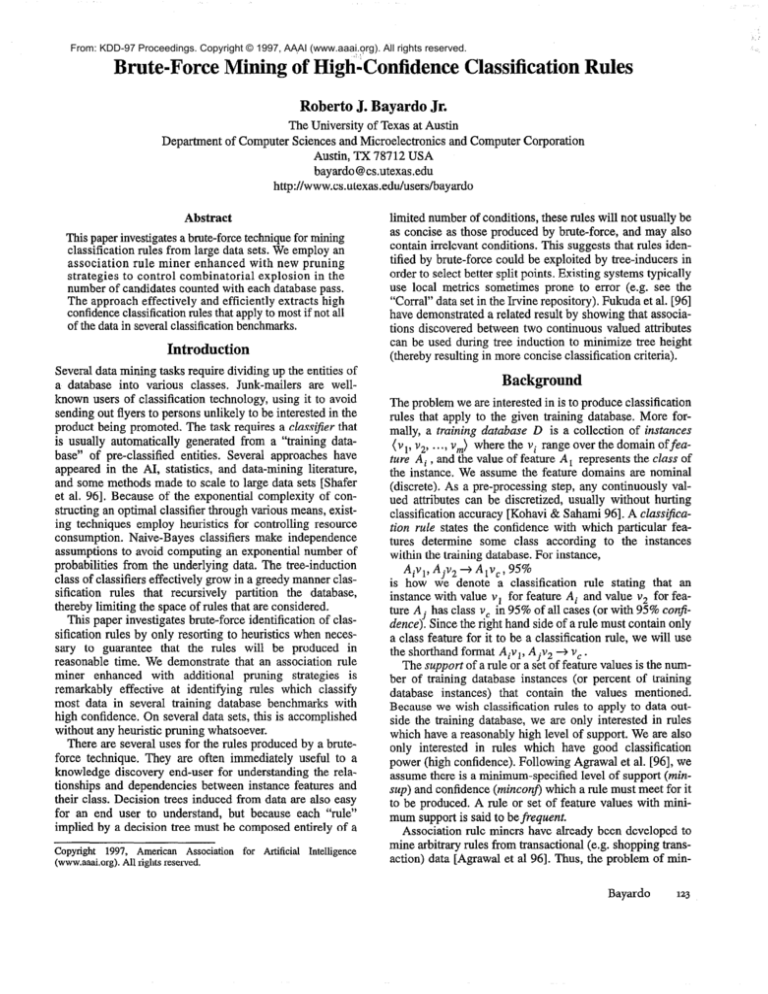
From: KDD-97 Proceedings. Copyright © 1997, AAAI (www.aaai.org). All rights reserved.
Brute-Force Mining of Highkonfidence
Classification Rules
Roberto J. Bayardo Jr.
The University of Texasat Austin
Departmentof ComputerSciencesand Microelectronicsand ComputerCorporation
Austin, TX 78712 USA
bayardo@cs.utexas.edu
http://www.cs.utexas.edulusersfbayardo
Abstract
This paperinvestigatesa brute-forcetechniquefor mining
classification rules from large data sets.We employ an
association rule miner enhanced with new pruning
strategies to control combinatorial explosion in the
numberof candidatescountedwith eachdatabasepass.
The approacheffectively and efficiently extracts high
confidenceclassificationrulesthat apply to mostif not all
of the datain severalclassificationbenchmarks.
Introduction
Severaldata mining tasks require dividing up the entities of
a database into various classes. Junk-mailers are welltnnxrrn
I\1n”*“a1
IIPPVP
UY”I.2
nf
“I
~lnacifirntinn
uI~i).Tl~nYuu”AI
tr=rhnnlnmr
LVVIIII”I”~,,
xl&mm
uuu1g
itI% tn
C” c~vnirl
U.“lU
sendingout flyers to personsunlikely to be interestedin the
product being promoted. The task requires a cZuss@erthat
is usually automatically generatedfrom a “training database” of pre-classified entities. Several approacheshave
appearedin the AI, statistics, and data-mining literature,
and some methods made to scale to large data sets [Shafer
et al. 961. Because of the exponential complexity of constructing an optimal classifier through various means,existing techniques employ heuristics for controlling resource
consumption. Naive-Bayes classifiers make independence
assumptionsto avoid computing an exponentialnumber of
probabilities from the underlying data. The tree-induction
class of classifierseffectively grow in a greedymannerclassification rules that recursively partition the database,
therebylimiting the spaceof rules that are considered.
This paper investigatesbrute-force identification of classification rules by only resorting to heuristics when necessary to guarantee that the rules will be produced in
reasonabletime. We demonstratethat an associationrule
miner enhanced with additional pruning strategies is
remarkably effective at identifying rules which classify
most data in several training databasebenchmarks with
high confidence.On severaldata sets, this is accomplished
without any heuristic pruning whatsoever.
There are severaluses for the rules producedby a bruteforce technique. They are often immediately useful to a
‘knowledgediscovery end-userfor understandingthe reiationships and dependenciesbetween instance features and
their class. Decision trees induced from data are also easy
for an end user to understand,but because each “rule”
implied by a decision tree must be composedentirely of a
Copyright 1997, American Association for Artificial
(www.aaai.org).All rights reserved.
Intelligence
limited numberof conditions,theserules will not usually be
as concise as those producedby brute-force, and may also
contain irrelevant conditions. This suggeststhat rules identified by brute-force could be exploited by tree-inducersin
order to selectbetter split points. Existing systemstypically
use local metrics sometimes prone to error (e.g. see the
“Corral” data set in the Irvine repository).Fukuda et al. [96]
have demonstrateda related result by showing that associations discoveredbetween two continuous valued attributes
can be used during tree induction to minimize tree height
(therebyresulting in more conciseclassificationcriteria).
Background
Tineprobiem we are interestedin is to produceciassiiication
rules that apply to the given training database.More formally, a training database D is a collection of instances
( Vl, v2, -*a,vm) where the vi rangeover the domain offeature Ai , and the value of feature A, representsthe class of
the instance.We assumethe feature domains are nominal
(discrete).As a pre-processingstep, any continuously valued attributes can be discretized, usually without hurting
classificationaccuracy[Kohavi & Sahami961.A classification ruZe states the confidence with which particular features determine some class according to the instances
within the training database.For instance,
Aivl, Ajv2 ~ A~v,, 95%
is how we denote a classification rule stating that an
instancewith value y1 for feature Ai and value v2 for feature A j has class vc m 95% of all cases(or with 95% conjidence). Sincethe right hand side of a rule must contain only
a class feature for it to be a classification rule, we will use
the shorthandformat Aivl, Aiv2 -+ v, .
The support of a rule or a set of featurevaluesis the number of training databaseinstances (or percent of training
database instances) that contain the values mentioned.
Because we wish classification rules to apply to data outside the training database,we are only interested in rules
which have a reasonablyhigh level of support. We are also
only interested in rules which have good classification
power (high confidence).Following Agrawal et al. [96], we
assume there is a minimum-specified
level of support (minsup) and confidence(minconJ) which a rule must meet for it
to be produced.A rule or set of feature values with minimum supportis said to beffequent.
Association rule miners have already been developedto
mine arbitrary rules from transactional(e.g. shoppingtransaction) data [Agrawal et al 961. Thus, the problem of minBayardo
123
ing classification rules in a brute-force manner is a special
case of this particular problem, though applied to morestructured data. Unfortunately, as we later demonstrate,
association rule miners when applied without modification
to classification data lead to combinatorial explosions
which prevents them from being useful in all but the simplest of data sets. We enhance an association rule miner
with several additional pruning strategiesto make it more
useful for mining classification rules from classification
data. First, we review the ideas behind efficient association
rule mining of transactional data.
With transactional data, each instance in the database
does not have a fixed number of features. Each instance is
instead a collection of one or more items. Let I denote the
set of all items mentioned in the database.An itemset is any
subset of I. Association rule miners such as Apriori
[Agrawal et al. 961 operate by making several passesover
the database,with the i th passused for computing supports
of itemsets of size i , Rather than counting the support of
7;: g”de’a;si~~;ta;f
r’li “, y;~~~u~;;~ppYn~
. 3
strategy we call subset-sup 6:h t-based pruning. Before each
pass i , it uses the set of frequent itemsets found from the
previous pass i - 1 (denoted as Fi _ t ) to compute a set of
candidate itemsets Ci for which support wiii be counted.
The candidate set Ci is computed as the set consisting of
any i -itemset such that all of its i - 1 item subsetsare in
F i- I . For the first pass, C, = I. Though this pruning
strategy does not change the worst casecomplexity of each
pass, in practice it is effective becausethe irregularity of
transaction data ensures that only few itemsets, once i
becomes sufficiently large, are frequent. Efficient datastructures for implementing these techniquesare detailed in
[Agrawal & Srikant 941.
There are other strategiesfor improving the performance
of association rule miners such as applying hash-based
reducers for minimizing candidatesto count [Park et al. 951
and restricting the set of tuples examined to those that are
(potentially) relevant to the current pass (e.g. AprioriTID
[Agrawal et al. 961, and [Park et al. 951). These techniques
are complementary to the pruning strategies we propose
next.
Additional Pruning Strategies
Given a classification training database, we can treat the
potential feature values Ajv as the set of items Z and apply
an association rule miner such as Apriori to mine association rules. Given unlimited resources,it would find all rules
(including classification rules) that meet the minimum support and confidence requirements. The problem with this
mnrnsch
-FL------
is that eyep = --_---_-instmca - _^_
in 8 ciassificatjon
--
d_&bgse
has exactly m features, so assuming the domain of each
feature is reasonably restricted, even large itemsets are
likely to have minimum support. We often found the subsetsupport-basedpruning strategy ineffective on classification
data until after several passesof the algorithm, leading to
uncontrollable growth in the number of candidates.Additional strategiesfor controlling this explosion are described
17.4
KDD-97
here. The first techniquesare non-heuristic in the sensethat
they do not reduce the potential rule space considered. The
last techniques involve heuristics that can either increase
the granularity of the rule space searched,or reduce it by
eliminating some items from consideration.
Pruning Strategy 1 - Value Exclusion
This strategy exploits the fact that in classification data,
items from the samefeature (e.g. Aivl and Aiv2) can never
be contained by the same instance. To implement it, the
candidate generator should avoid producing candidates
with more than one value for the same attribute. After the
second databasepass, this pruning strategy is effectively
accomplished by the subset-support strategy already
present in Apriori since any 2-itemset with values from the
same feature will have support zero. Nevertheless, this
strategyspeedsup the secondpass,and it also speedscandidate generation on subsequentpassessince subsetsfor candidatespruned by this technique do not have to be explicitly
checkedby subset-support-basedpruning.
Pruning Strategy 2 - (Near) Equivalence Exploitation
Occasionally an itemset will have support that is (nearly)
equivalent to the support of one of its subsets.For example,
supposewe have an itemset S = { Aivl, _AIv2} whose support is equal to the support of j Aivl > . criven this fact, we
know that any rule containing S as a subsetis equivalent to
the rule formed by removing A .v2 since it will have equivalent support, equivalent conIt:dence, and applies to an
equivalent set of databaseinstances.To prevent theseequivalent rules from being generatedor incurring any overhead,
the exact-equivalencestrategy removes from the set of frequent itemsets any set S having a subset with equivalent
support before forming the next set of candidates.
A more common caseariseswhen the support of an itemset is very near the support of one of its subsets.For example, supposethe support of {X, Y} is equal to the support
of {X} minus a small value t . Now consider any other feature Z and a class feature C. We can estimate the confidence of rule X, Y, 2 + C using the following inequality:
sup(XZC) - t
I confidence I ssu$$??y,
sup(Xz>
If this confidence interval is entirely below minconf, then
there is no need to compute the support of itemset
{X, Y, 2, C} during the fourth pass.
Unlike exact-equivalence,the near-equivalencerule must
be carefully applied becausein subsequentpassesthe support of a superset of an itemset pruned by the technique
may be required. Extending the previous example, even if
we know {X, Y, Z, C> does not imply a high confidence
rule, itemset ( W, X, Y, 2, C} may imply a high confidence
rule
~..~.festimated
\-~.~---...-~usinp
..L---- the
.--- same
L..---- ineoualitv
---- -,....---, technioue)
.- -------,1-, and
..--- be
potentially frequent. For this case even though
{X, Y, Z, C} is not contained in the set of computed frequent itemsets, we must ensure that {W, X, Y, 2, C} gets
generatedas a candidate in order to preserve completeness.
Unfortunately, not having the support of {X, Y, 2, C} hinders the ability of subset-support based pruning to determine whether {W, X, Y, 2, C} is potentially frequent, so
there is a trade-off between strength of this “near equivalence” strategy and the strength of subset-supportbased
pruning.
Pruning Strategy 3 - Rule Structure Exploitation
Recall that we are only interested in classification rules.
Computing the support of a classification rule requires we
know the support of both the entire rule, and the support of
the left-hand side of the rule. If we can determine that for
every class item v, the rule Aiv r, A jvZ + vc is not of interest, then there is no need to count the support of
{Aivl, y2).
This pruning strategy exploits this fact. An
itemset of Ci is said to be uselessif, for some i - 1 item
subset s’ of S, there exists no class item v, such that
s’u {A lv’c} is in Ci . To implement this strategy, useless
candidatesare pruned before the databasepasscommences.
There are other potential strategies for exploiting rule
structure, but several of them may conflict with the other
strategieswe propose. For instance, the miner could avoid
counting the support of an itemset S that does not contain a
class item until an itemset consisting of S and some class
item v is known to be frequent. This strategy unfortunately
delays the point at which we can apply a strategy that
requires the support of S (such as, potentially, strategies2
and 4). The strategy we suggest above allows rule structure
to be expioited to a lesser degree, though it provides the
guaranteethat after pass i we know all frequent itemsetsof
size i , and not just those containing class items. Inevitably
some data sets will benefit from stronger rule-structure
exploitation at the expenseof other strategiesaffected by it,
though this trade-off remains to be fully investigated.
Pruning Strategy 4 - Redundancy Exploitation
The previous pruning strategies do not result in any
information loss in the sensethat an associationrule miner
ignoring them will produce a set of rules that applies to the
same set of tuples with the same confidence and support.
Strategy 2 can result in fewer rules being returned, but only
because rules that are equivalent to some other rule are
removed. The next pruning strategy is different than those
previous because it can result in some information loss,
though the information lost can be regarded as irrelevant
with respect to the given level of confidencedesired.
The idea is to prevent continued effort at classifying
instancesalready classified by existing rules with high confidence. To implement such a technique, after each pass i ,
we identify the frequent itemsets that imply rules with confidence exceeding minconf. During the next databasepass,
tuples can be marked if they are covered by this set while
counting candidate supports. During counting, also determine whether a candidate is supported by at least one
uncovered instance. At the end of the pass, if the candidate
:, ‘..,.+
-..--^_ LGu
&,,.IL..
^+ I..--&
^I^ uJvGIcu
^^_.^__2 11IYLilllc;G,
:-,4 ^-^- :r
^^I L1s
l”L supp”‘
uy s11
IGLlLyL
UIIC
IL cm1
LJG
excluded from the set of frequent itemsets before forming
the next set of candidates.
Marking tuples is unfortunately expensiveor impractical
in some situations. Luckily it is possible to approximate this
pruning technique without any tuple marking. The idea is to
exploit the fact that if a rule R meets minimum confidence,
then any rule containing R will apply to only covered
instances.Itemsetsrepresenting such rules can therefore be
pruned from the candidate set before counting commences.
Pruning Strategy 5 - Granularity Modification
Though an explosion in candidatesto be counted with a
database pass is often substantially ameliorated by the
above strategies,in several casesthey are not enough and
further information-loss must be accepted. In the worst
case, given in features
E potential valuations of each
feature, there are up to I’ ? candidatesduring pass i . This
pruning strategyreducesrl6 I’ term of this bound. The idea
is to combine particular valuations of some feature into a
single, larger granularity feature. For instance, if a feature
Ai, i # 1 can be labelled with values vl, v2, vg , the rule
considers treating any pair of those values as a single composite item. The rule can be applied recursively in that a
composite item A,V can be further combined with another
feature Ajv or even A,V, to form another composite item.
The rule should not be applied to form a composite item
consisting of all potential valuations of the involved feature,
since every instance will, by definition, contain such an
item. Once a composite item is determined, the next set of
candidatesis formed from the set of frequent itemsets modified by replacing each occurrenceof the items used to form
the composite item with the composite item itself. Since
this results in duplicate itemsets, the implementation must
be made to remove them.
Various strategiescan be used to determine which feature
valuationsto combine in order to produce a composite valuation. The strategy we use is to seek out pairs of rules from
the last produced set of frequent itemsets F, that differ by
exactly one valuation of a particular feature. The pair of
rules which comes nearest in confidence will be used to
obtain the composite item. Given a feature whose values
were obtained by discretizing a continuous attribute,
anothertechnique would be to combine adjacentportions of
the discretized space.
Pruning Strategy 6 - Feature Selection
This strategyis a feature selection step applied when necessaryinstead of as a preprocessingphase.It contends with
the p;ential explosion in the number of candidatesdue to
the . term in the worst-case bound on candidates.The
idea0‘H o dynamically select a feature Ai mentioned in the
most recently obtained F, for removal. Any itemset in Fj
to contain the selected feature is removed from F, before
forming the set of candidatesfor the next pass. The feature
selectedfor removal should be, by some measure, the least
useful in predicting the class. For the evaluation below we
compute the mutual information Z(Ai, A,) for every feature appearing in F, and select the feature with the lowest
value for removal. A better strategy could consider the
,-----. rUlC5
-..1-, UBIIV’
>--1-.-J
Le.
AL:-IT---r:-----.:A-2 L-.
ALIIllUIlIldllUII
~IUVlWU
Oy
UK
12KgGSl
SU
IJ)’ UK
miner at the point the strategy is applied.
Evaluation
We implemented the Apriori algorithm and enhanced it
with the above pruning strategiesin order to evaluate their
effectiveness.Pruning strategies 1 through 4 were uncondiBayardo
125
Database
Chess
instances
3,196
features
37
values
2
Connect-4
67,557
43
3
I-hTll
UVAAUI
128
7
2
DNA
3,174
61
4
Flare
1,066
11
3
Led7
3,200
8
2
Letter
20,000
17
16
958
10
3
Tic-Tat-Toe
Vote
435
17
confidence
90%
100%
90%
100%
3
runtime
speedup
176
?
189
?
1382
?
1437
?
9mz
/“I”
.04
25%
100%
.OS
0%
90%
239
?
23%
?
100%
.64
915%
90%.
100%
.87
647%
90%
1.7
23%
100%
1.7
32%
23.4
182
90%
.IlJU-70
ArIm
a.4
-0 *
*“A
I6L
90%
2.8
0%
2.8
0%
100%
3.7
?
90%
100%
22.0
?
tionally applied with each pass.For strategy 4, we used the
approximationbasedon rde sub-settinginsteadof the complete tuple-marking implementation. For strategy 2, we
only implemented the exact-equivalencecase. When the
candidateset being generatedafter a passexceedsa particular threshold, pruning strategies5 and 6 were invoked. On
our machine (64MB SpareUltra l), the thresholdwas set to
30,000 candidatessince larger sizes causedthrashing. For
applying strategies5 or 6, our implementationfirst scores
all items using the feature selectionmetric of pruning strategy 6. If the chosen feature has more than two potential val-
uations, then pruning strategy 5 is used to create a
composite item on that feature. If the feature has only 2
potential valuations, then pruning strategy 6 is invoked and
that featureis removed.
We ran the algorithm on severaldata setsfrom the Irvine
rmm&tnr.,
‘“y”Y’
w’J
thsrt
LAILaCrnntn;ncvl
““IILu)IIVU
nnmincal1.r
““““,‘U”J
w~l,~~rl
.UIVYU
featmwc
IYUCUIVO.
l-ho
LllV
table above displays the performance in CPU seconds of
our enhancedApriori on the various data sets for 90% and
100% confidencelevels, using a minimum supportof 1% or
20, whichever is the maximum. It also presentsthe speedup
over un-enhanced Apriori. In some cases un-enhanced
Apriori caused our machine to thrash (we did not cache
candidatesto disk), at which point it was halted. For these
cases speedup is not reported. After speedup,the table
*,...a..+“...-L*..
,c..,,,An
s..,^...l.,
,I.-.*,
IqJ”lLS *I..,
LLlG
,lUlll”W “I
pasatis..,“..:“,.A
IcqUIIGlJ““GI
CllGULICLL.
On all but the DNA, Chess,and Connect-4data sets, the
miner did not have to ever invoke the lossy pruning strategies 5 a& 6. DNA proved the most difficult in this regard
becauseit consists of 62 featuresother than the class, each
with four potential valuations. The table displays as “loss”
the number of composite valuations formed summed with
the number of featuresremoved. Note that performanceon
the Vote data set increases substantially with lower confi_I---- TV”::” AL”
-c Pruning
--.--:-- slraragy
^I--A--__4A .-.1:-L
:- _.--.
UGIICG.
I 111sIS
LI~G---.-IL
I-~SUILUI
WIIIC;~IS
very
effective on this data set because after only two passes a
large percentageof the databaseis covered by high confi-
dencerules. The table also describesthe rules and the num126
KDD-97
passes
11
11
8
8
4
4
7
7
7
7
8
8
7
7
5
5
10
12
loss
33
33
35
35
0
0
196
197
0
0
0
0
0
0
0
0
0
0
rules
279
237
140
2
10
6
394
269
19
5
6
0
4
i
136
86
152
378
coverage
92.5
74.5
57.6
2.9
100
100
92.0
65.0
75.8
9.3
23.6
0
4.0
i.i
100
98.3
99.5
99.5
ber of rules found by the rule miner for each run on the
various data sets. Except for the noisy data set Led7 and
Letter, the rule miner was effective at attaining high coverage at 90% confidence.The poor coverageon Letter is not
due to information loss and can be improved by lowering
confidenceand/or support.
References
Agrawal, R., Mannila, H., Srikant, R. Toivonen, H. and Verkamo,
^^_.”-.y “1
“E fi.ss”uaLI”u
h”“^A”r:“.. 3-D..,“.
Al ..^_^ ^I lx‘
:..
ti.A T1. lnnl
177”. n--e
rila l-c”
IIIsL;““G‘
RWGb.T111f¶uYur~c~~
Knowledge Discovery and Data Mining, AAAI Press,307-328.
Agrawal, R., and Srikant, R. 1994. Fast Algorithms for Mining
Association Rules. IBM Research Report RJ9839, June 1993,
IBM Almaden ResearchCenter, San Jose,CA.
Fukuda, T., Morimoto, Y. and Morishita, S. 1996. Constructing
t3ffidPnt
YI,,~,cI,II
n-do;UbL,I~I”,,
7hPa
llGL&l h.,
“J
TTrkrr
“OllL~
nnt;m;l.,?rl
“yL,,u*~u
hb-r;r.
Aec,4a1’1U,,Lti1.~ I)uu”“Iu-
tion Rules. In Proc. of the 22nd Very Large Data Bases Conference, 146-155.
Kohavi, R., and Sahami M. 1996. Error-Based and Entropy-Based
Discretization of Continuous Features.In Proc. of the Second Int’l
Co@ on Data Mining and Knowledge Discovery,
Park, J. S., Chen, M.-S., Yu, P S. 1996. An Effective Hash Based
Algorithm for Mining Association Rules. In Proc. of the 1995
SIGMOD Conference on the Management of Data, 175-186.
Shafer, J. C., Agrawal, R., and Mehta, M, 1996. SPRINT: A Scalable Parallel Classifier for Data Mining, In Proc. of the 22th Znt’l
Co@ on Very Large Databases, 544555.
Srikant, R. and Agrawal, R. 1996. Mining Quantitative Association Rules in Large Relational Tables. In Proc. of the ACM-SZGMOD Conference on Management of Data, 1- 12.


